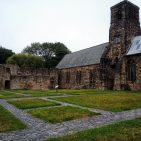This was the next in the new environment….armed with masks and gel, we made the 307 mile journey up to Sunderland to cat sit to allow Scott a well earned week away. The journey up went remarkably smoothly, helped by a picnic lovingly prepared by yours truly. Managed to catch up with Scott and Gilli before their next day departure and then eight days of us and the cats. It should be said at this point that Mrs. No Name admirably handled virtually all of the domestic cat duties throughout the stay, including a transformed but still tetchy Bingo, who although generally much more placid still managed to showcase disdain and distaste for her nightly medication.

Having said that, Bingo has shifted from completely shunning all forms of human contact to a constant need for comfort and reassurance throughout the day – a complete transformation it has to be said. I should also register at this point that we have few photos of our week in the North East thanks to an unfortunate slip with the SD card on our return. (Ok, so I formatted the card, erroneously assuming the photos had already been transferred to the PC). Which is a shame, as we did do a little bit of travelling in the 7 days we were there.
First up was Aydon Castle (in essence a fortified manor house), which English Heritage had left ‘As Is’. Almost completely intact, it is one of the finest and most unaltered examples of a 13th century English manor house. Set in a beautiful and secluded Northumberland woodland, it was originally built as an undefended residence, but was almost immediately fortified on the outbreak of Anglo-Scottish warfare.

Nevertheless it was pillaged and burnt by the Scots in 1315, seized by English rebels two years later, and again occupied by Scots in 1346. The castle later became a farmhouse in the 17th century and was lived in up until 1966. Well worth the visit we thought and certainly not overcrowded.
The following day we visited the Lambton Estate, where around 11 km of permissive seasonal walks have been created across the Estate, for residents and visitors alike, to enjoy the nature, landscape and heritage of Lambton Park – great pictures of Lampton Castle were taken but of course now lost to posterity (or stupidity if you wish to be harsh…). We also managed to visit Hylton Castle in Sunderland, which due to the coronavirus situation, could currently only be viewed from the outside. Looked interesting and remarkably well preserved and we would welcome a return visit should the interior reopen at some point in the future.

Finally, we decided to visit St. Paul’s Monastery, one of Europe’s most influential centres of learning and culture in the 7th century. The remains standing today are from the medieval monastery, but part of the Anglo-Saxon monastery survives today as the chancel of St Paul’s Church. (Hooray, a picture at last, preserved because it was taken on my phone!). The monastery’s reputation spread throughout Europe, chiefly because of the scholarly writings of the Venerable Bede. Bede entered St Peter’s in about 680 at the age of seven, and spent his life in the twin monastery of Wearmouth–Jarrow, which he described as ‘one monastery in two places’. Inspired by the scholarship and new style of monastic life here, he dedicated his life to study. He wrote more than 60 works, most notably the first history of the English, the Ecclesiastical History of the English People. He died in 735. Who would have thought that such an important site of learning should be so ‘under signposted’ – especially as it is now one of the best understood Anglo-Saxon sites in England.
So, apart from the photo debacle, a very successful foray and the furthest we have been since the easing of lockdown.
